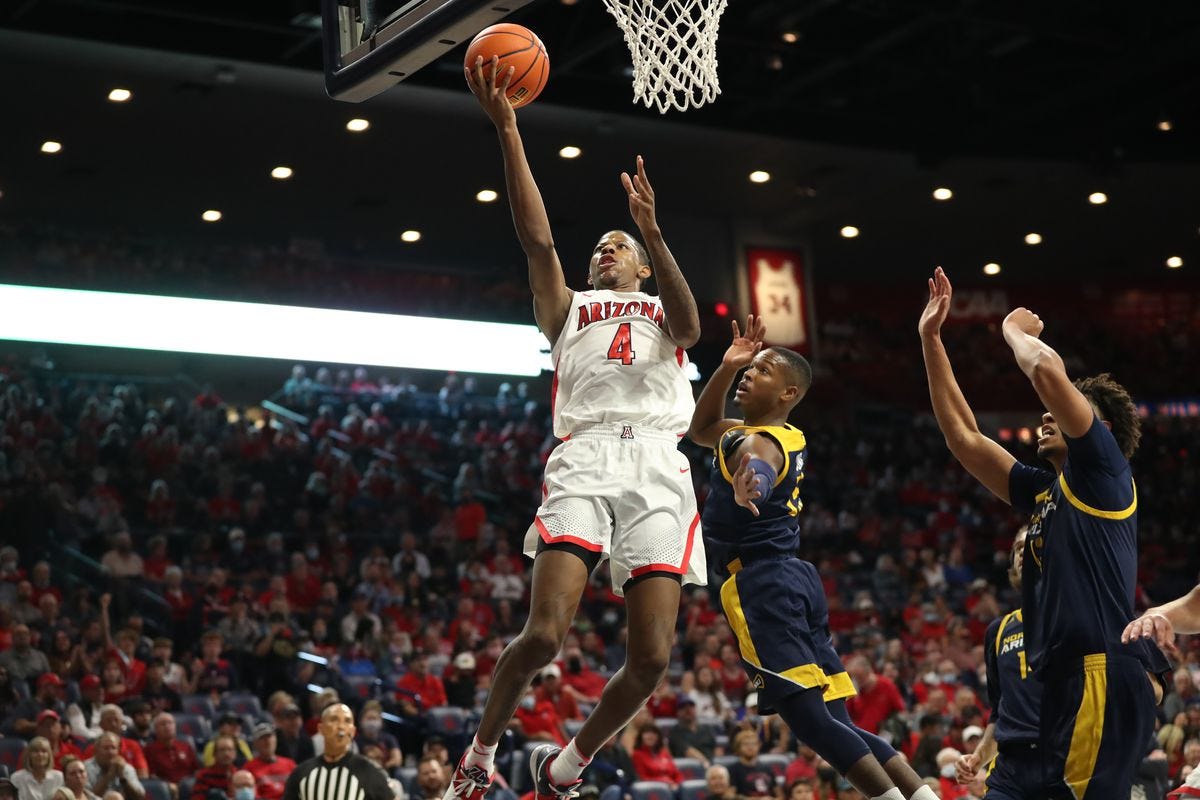Dalen Terry: 2022 NBA Draft Scouting Report
A late riser shooting up boards, Terry is a Swiss Army Knife of a prospect who improved greatly during the season. Are NBA teams getting in on the ground floor?
If you buy into our Three Pillars philosophy of team-building, you agree with one simple tenet of drafting: at the top of the draft, swing for players who can become your superstars. Role players — the ones who are more complementary by nature — can come later, as they (by definition) serve a less vital role in terms of roster construction.
What we struggle with in that regard is defining where the drop-off is during the draft from a value standpoint, where it makes more sense to start prioritizing those high-end role players as opposed to the guys who can score 20 a night or look like future All-Stars. The most frustrating-but-true answer: it depends on the draft class.
Arizona swingman Dalen Terry played a complementary role on one of college basketball’s best teams last season. He took six shots a game, played fewer than 30 minutes a night and left very few scouts buzzing about his star potential. But at 6’7” with a 7’0” wingspan and point guard skills, Terry is a do-it-all kind of role player who has a clear impact on winning. He was Arizona’s best perimeter defender, passer, and by the end of the season, turned himself into a competent 3-point threat.
That aforementioned shooting was always the missing piece of the puzzle for Terry. He thrived with the ball in his hands in transition, was slimy enough to get to the rim off the bounce, knew how to cut without the ball and provided a much-needed dose of energy on the offensive glass. Few guards were as impactful at chasing second-chance points as Terry. But the shooting… the shooting was never there. He shot 14-43 (32.6%) as a freshman, an incredibly small volume given his position and minutes played.
The sophomore season began pretty much the same way. While his role and minutes expanded, Terry’s shooting didn’t seem to take a step forward. Through the first 23 games of the season, Terry was shooting 26.7% from 3, going 12-45 and barely upping his volume.
Midway through the season, he made a slight change to his shooting base, getting his feet wider apart and more square to the rim. With the developed reputation as a non-shooter (both in terms of impact and willingness), Terry noticed he had all the time in the world to get his shots off, as opponents weren’t scrambling to contest his shots. He took more time to get set, got those feet farther apart, and start to knock down his triples.
The first glimpse we got of this improved for really came on the February 12th game at Washington, where he went 2-2 from deep against the Huskies’ patented 2-3 zone. From that game to the end of the season (14 games), Terry went 16-32 (50%) from deep. While that is a small sample — and far too small to call him an elite shooter — it’s linked to a legitimate mechanical change, one that should be sustainable in the future to make him at least a sturdy spot-up threat.
A lot will change for Terry as he adds that shooting consistency and opponents start to guard him differently. The time he needs for those shots will disappear, and the form will need to get faster. He’ll also have the ability to get to the rim more, blowing past closeouts that now have urgency to get a contest, where both his finishing and playmaking will pop. We saw the finishing improve during that stretch of games, going from 53.3% from 2-point range to 63.3% after February 11th.
That scoring efficiency pairs well with a low-usage role that Terry can thrive in at the pros. He’s able to earn minutes despite not being a high-volume scorer because, frankly, he’s a really damn good defender. He’s super long, quick on his feet, and engaged on-ball and off-ball. By our measure, he was the most important defender for the Wildcats this year, and definitely their best. Cross-matching Terry against smaller point guards created havoc; he’s so good at chasing over the top of ball screens and contesting pull-up jumpers that his NBA future comes in providing the same frustration to smaller guys in the pros.
Terry is the first player since the NCAA started recording advanced stats in 2007 to play 1000 minutes in a season with his level of an assist rate, low of a turnover rate, Defensive Box Plus-Minus, and shoot 50% from the field. His combinations of playmaking without mistakes, defensive impact and efficient scoring makes him scalable as an elite role player.
How much more upside is there that remains untapped?




